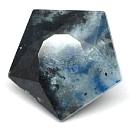|
|
||||||||||||||||
|
||||||||||||||||
|
||||||
|
|
|
|
Bertossaite
|
|
| | |
| Discovered in 1965; IMA status: Valid (IMA Approved 1965) | ||
|
| ||
|
Chemistry |
|
|
| |
|
(Li,Na)2(Ca,Fe2+,Mn2+)Al4(PO4)4(OH,F)4 | |
|
|
Lithium Sodium Calcium Iron Manganese Aluminum Phosphate Hydroxide Fluoride |
|
Molecular Weight: |
609.80 gm |
|
Composition: |
Lithiium |
2.28 % |
Li |
4.90 % |
Li2O |
|
|
Calcium |
6.57 % |
Ca |
9.20 % |
CaO |
|
|
Aluminum |
17.70 % |
Al |
33.44 % |
Al2O3 |
|
|
Phosphorus |
20.32 % |
P |
46.55 % |
P2O5 |
|
|
Hydrogen |
0.66 % |
H |
5.91 % |
H2O |
|
|
Oxygen |
52.47 % |
O |
|
|
|
|
|
100.00 % |
|
100.00 % |
= TOTAL OXIDE |
|
|
|
||||
|
Classification |
|
|
| |
|
Phosphates | |
|
8/B.28-10 | |
|
|
8 : PHOSPHATES, ARSENATES, VANADATES
|
|
Related to: |
Bertossaite-Palermoite Series. The calcium analogue of Palermoite. |
|
Varieties: |
None |
|
Synonyms: |
IMA1965-038 |
|
|
|
|
Crystal Data |
|
|
|
|
|
Massive |
|
|
None |
|
|
|
|
|
Physical Properties |
|
|
|
|
|
Good on {100} |
|
|
Irregular/Uneven to sub-conchoidal |
|
|
Brittle |
|
|
6.0 |
|
|
3.10 (g/cm3) |
|
|
None |
|
|
Not Radioactive |
|
|
|
|
|
Optical Properties |
|
|
|
|
|
Pale pink; colorless in transmitted light |
|
|
Semi-transparent |
|
|
Vitreous |
|
|
1.624 - 1.642 Biaxial ( - ) |
|
|
0.018 |
|
|
Moderately strong, r < v |
|
|
None |
|
|
|
|
|
Occurances |
|
|
|
|
|
Geological Setting: |
Thought to be formed during a late calcium-rich phase of mineralization in a lithium-bearing granite pegmatite. |
|
Common Associations: |
Amblygonite, Lazulite-Scorzalite, Augelite, Brazilianite, Apatite, Crandallite, Trolleite, Samuelsonite, Quartz |
|
Common Impurities: |
Fe, Mn |
|
Type Locality: |
Buranga pegmatite, Gatumba District, Western Province, Rwanda |
|
Year Discovered: |
1965 |
|
View mineral photos: | |
|
|
|
|
More Information |
|
|
|
|
|
| |
|
|
|
|
For more than 35 years after its discovery Bertossaite was thought to be a one locatlity mineral until in 2003 Pierre Lefèvre investigated new samples of phosphates from the Rubindi-Kabilizi pegmatite, Rwanda, and discovered a new occurrence of Bertossaite in veins cross-cutting Montebrasite, Scorzalite, and Brazilianite. This investigation was part of Lefèvre's Master’s thesis at the University of Liège, Liège, Belgium. Bertossaite is often found associated with Apatite, Brazilianite, Burangaite, Quartz, Scorzalite and Trolleite. The picture above shows a gem with faintly-pink to white Bertossaite with blue Burangaite. Bertossaite is typically semi-transparent with vitreous luster and moderately strong dispersion and a Moh's hardness of 6. The combination of faintly pink to white Bertossaite and royal blue Burangaite makes for very attractive specimens and gems. Bertossaite
distribution: at the type locality in the
Buranga pegmatite, near Gatumba, Rwanda. Also at the
Rubindi-Kabilizi pegmatite, located 3 km WNW of Muhororo village, south of the Rubindi river, 50 km west of Kigali, Rwanda.
|
|
|
We
have not photographed our Bertossaite
gems yet. Please
check back soon. |
